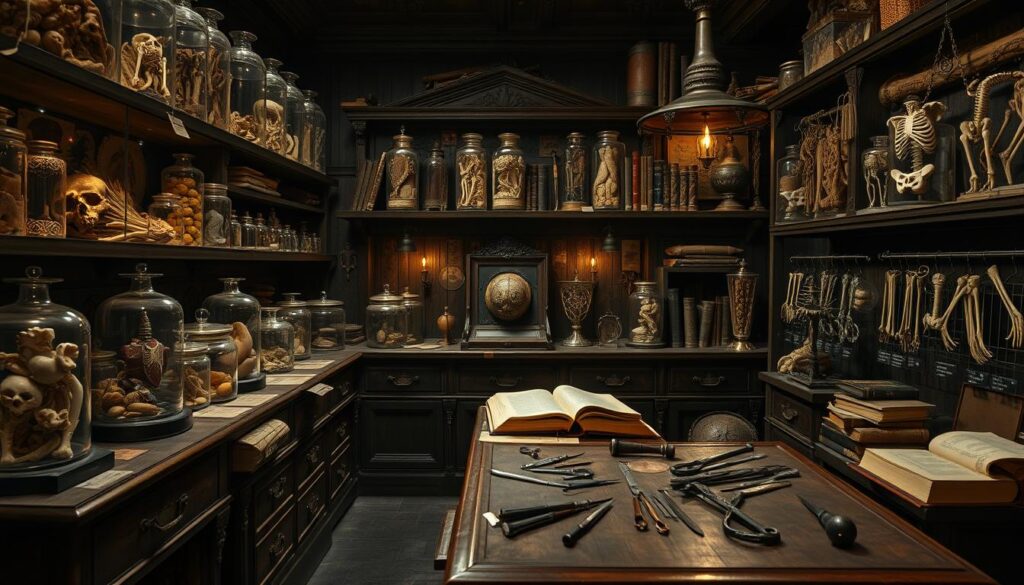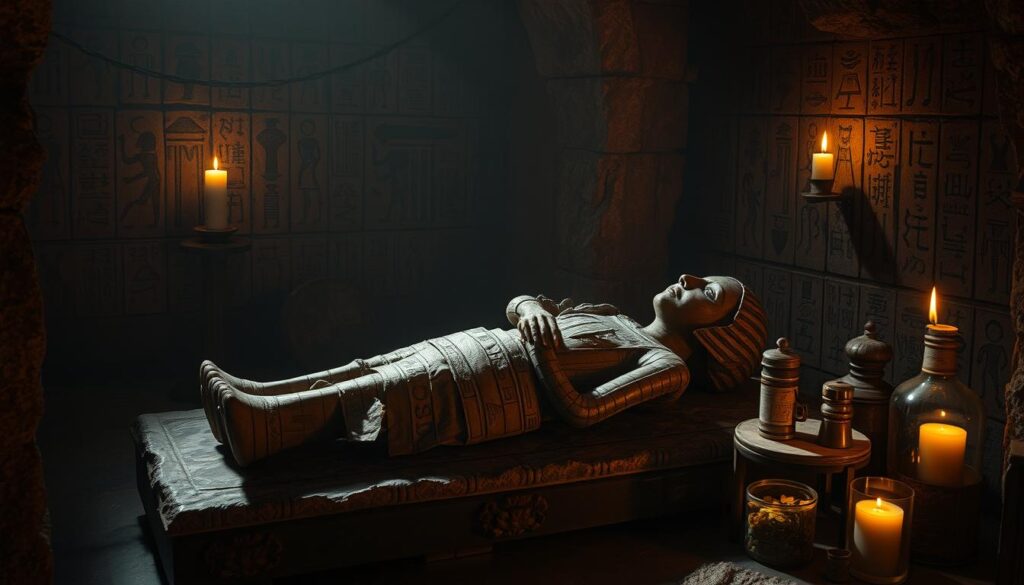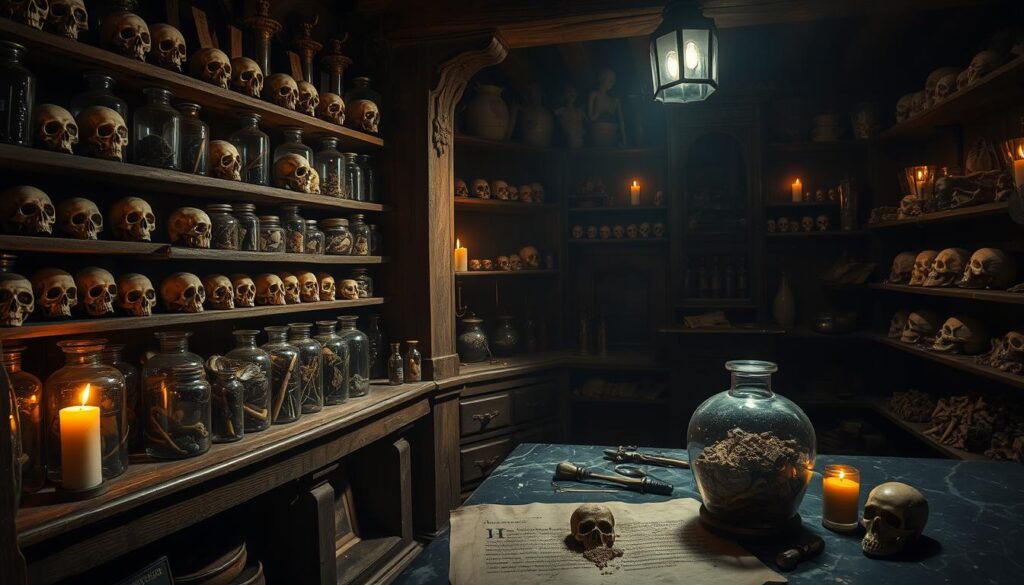For centuries, Europeans, including royalty and scientists, used human remains as medicine. This was common in the 16th and 17th centuries. They used bones, blood, and fat to treat various illnesses. This practice, known as Corpse Medicine or medicinal cannibalism, was surprisingly widespread.
Egyptians mummies were stolen, and skulls were taken from Irish graves. Grave robbers sold these body parts to meet the demand. This practice lasted until the late 19th century, with the last recorded sale in 1924.
These Morbid Medical Interventions were seen as legitimate treatments. Powdered mummies and skull fragments were used for many ailments. The demand was so high that the English had to import Irish skulls by the 17th century.
The Origins of Human-Based Medical Treatments
Human-based remedies in medicine go back to ancient times. In ancient Rome, people drank the blood of dead gladiators, thinking it would give them strength. Later, in 15th-century Europe, philosopher Marsilio Ficino suggested drinking young people’s blood to stay healthy.
Ancient Medical Practices and Beliefs
These ideas came from the belief that Postmortem Therapies and Cadaveric Treatments held the essence of life. The ancient Romans believed in keeping a balance of four humors – blood, phlegm, yellow bile, and black bile – for health.
The Rise of Corpse-Based Remedies in Medieval Europe
In medieval Europe, using human remains for medicine grew. Doctors looked for cures in other bodies. They used parts like blood, flesh, bone, fat, brains, and skin for many ailments, from epilepsy to depression.
Cultural Acceptance and Medical Theory
The use of Postmortem Therapies, Cadaveric Treatments, and Thanatological Medicine was accepted. Medical theories supported it, making it common in Europe until the 18th century.


Understanding Corpse Medicine in Early Modern Europe
In early modern Europe, using human remains for medicine was common. People from all walks of life took Necrotherapeutics, Carcass-based Cures, and Death-Derived Pharmaceuticals to cure illnesses. They believed the human body had healing powers.
Gravediggers sold body parts, and mummies were stolen from Egypt. In the 17th century, a doctor made a drink with human skull and chocolate. King Charles II drank a concoction with human skull in alcohol.
People thought eating human remains gave them strength and spirit. This belief wasn’t just in Europe. The Romans and philosopher Marsilio Ficino also used human parts for medicine.


The use of Carcass-based Cures started to fade in the 18th century. This was due to better eating habits and hygiene. Yet, some old practices, like mixing a young woman’s skull with treacle for epilepsy, lasted longer. Today, we still use human parts for healing, but in a more scientific way.
The Egyptian Mummy Trade and Medical Applications
The idea that mummies could heal came from a wrong translation of “mumia,” a natural substance. People thought mummies, the preserved bodies of ancient Egyptians, had special healing powers. This led to a big trade in mummies and fake ones, driven by the demand for Corpse Medicine and Morbid Medical Interventions.
The Business of Mummy Trafficking
As more people believed in the healing powers of mummies, a new business started. People and groups began stealing mummies from Egyptian tombs. They sold these to European pharmacies and rich people. Some even made fake mummies from dead bodies, making the trade even bigger.
Methods of Preparation and Usage
Mummies were ground into powder and used in many medicines. These Corpse Medicine mixtures were thought to cure many things, like wounds and improve health. But these medicines were very expensive, so only the rich could buy them in the 16th and 17th centuries.


Using mummies for medicine lasted into the 20th century. In 1908, some German companies still sold mummy powder. But as science learned more, using human remains for medicine became less common. This led to the development of better, more ethical medical treatments today.
Blood-Based Treatments and Their Perceived Benefits
In the era of Corpse Medicine and Thanatological Medicine, blood was seen as very powerful. It was thought to hold the essence of life, making it valuable for treatments.
People wanted fresh blood so much that they waited at executions to get some. This blood was used to treat diseases like epilepsy and tuberculosis. It was also believed to bring back youth and energy, and was eaten in different ways.
The use of Human Decay Remedies and blood treatments shows old medical beliefs and culture. Though now seen as wrong and outdated, these practices were once common in seeking health.
The Role of Human Skulls in Historical Medicine
Human skulls were key in old medical practices. From the 16th to 18th centuries, Europeans used skull powder and moss for treatments. They believed these Death-Derived Pharmaceuticals could cure many diseases.
Skull Powder Preparations
Skull powder was made by grinding human skulls into a fine powder. Doctors like Paracelsus thought eating this powder could heal illnesses. This led to a big market for human remains, with skull sales recorded until 1778.
Therapeutic Applications of Skull Moss
The moss on human skulls was also seen as medicinal. It was thought to stop nosebleeds and other problems. This use of human remains was common among European aristocrats during the Enlightenment.


Using human body parts and blood in medicine lasted from the 1200s to the 1890s. It started to fade in the 19th century as science improved. This led to the end of magical medical theories.
Royal Endorsements and Elite Consumption
Corpse Medicine was not just for the poor. Even royalty, like King Charles II of England, used it. He drank “The King’s Drops,” a mix of human skull in alcohol. Thomas Willis, a brain science pioneer, made a drink for apoplexy with human skull powder and chocolate.
These treatments were not just for the common people. The rich and even kings used them. This made Corpse Medicine seem more acceptable and even prestigious.


It’s interesting that even famous people used human remains in their medicine. King Charles II and scientist Thomas Willis were among them. Their use helped make Cadaveric Treatments more accepted in society.
Scientific Understanding and Medical Theories of the Time
The scientific and medical views of the time helped spread Thanatological Medicine, Necrotherapeutics, and Death-Derived Pharmaceuticals. The idea that “like cures like” was key. It said eating certain body parts could fix problems in similar areas.
People also thought the “spirit” was part of us, linking body and soul. They believed eating from corpses could give them the dead person’s strength. Famous figures like Leonardo da Vinci supported using human remains in medicine.
Like-Cures-Like Philosophy
The “like cures like” idea was central in using human remains in medicine. It said eating certain parts, like brain or bone, could fix problems in the same areas of the patient. This idea led to the use of Death-Derived Pharmaceuticals, like mummy powder and crushed skulls.
Spirit and Vitality Concepts
The idea of “spirit” as a vital part of us drove the use of Necrotherapeutics. It was thought that eating from the dead could give us their strength and energy. This idea was accepted and promoted by many, making corpse-based medicine common.
The views of science and medicine, along with cultural acceptance, made Thanatological Medicine and related treatments popular in early modern Europe.
The Decline of Human-Based Medicines
The use of Corpse Medicine started to fade in the 18th century. This change came with new scientific discoveries and changing social views. These shifts made Morbid Medical Interventions less accepted.
But, Human Decay Remedies were still used in the 19th and early 20th centuries. In 1847, an Englishman was told to use a young woman’s skull to treat his daughter’s epilepsy. Even in the early 20th century, Mummy was still listed in a German medical catalog.
The last recorded use of blood from an execution was in Germany in 1908. This marked the end of Corpse Medicine. The decline was due to better understanding of anatomy and changing social views.
| Statistic | Data |
|---|---|
| Decrease in Cadaver Use in Medical Education | Greater than 50% since the 1980s |
| Veterinary Education Reliance on Cadavers | Heavily used for anatomical training, clinical skills labs, and research |
| Health Risks of Formaldehyde-based Preservation | Carcinogenic properties and neuropsychological effects with overexposure |
| Preference for Thiel Embalmed Cadavers (TEC) | Postgraduate students, especially those learning surgical methods, tend to prefer TEC due to improved smell and life-like appearance compared to formalin embalmed cadavers (FEC) |
The move away from Corpse Medicine was slow but sure. It was driven by scientific progress and changing social norms. As medical knowledge grew, using human remains for treatments became less acceptable, leading to its decline.
Conclusion
The history of Corpse Medicine, Postmortem Therapies, and Cadaveric Treatments is complex and disturbing. These practices seem barbaric today but show what people believed and knew back then. As science and society changed, these practices fell out of favor.
Today, we still use parts of the human body for healing, but in a better way. Things like organ transplants and blood transfusions show how our views on life and death have changed. This change shows how our society is evolving in how we see the human body, alive or dead.
Looking into the history of Corpse Medicine and others helps us understand medicine, culture, and humanity. It teaches us about the past and guides us in making decisions about healthcare today. This journey helps us face the ethical questions and new views that shape our health care tomorrow.
Source Links
- https://collegeofphysicians.org/programs/education-blog/corpse-medicine/
- https://www.nationalgeographic.com/history/article/mummy-eating-medical-cannibalism-gory-history
- https://www.routledge.com/Mummies-Cannibals-and-Vampires-The-History-of-Corpse-Medicine-from-the-Renaissance-to-the-Victorians/Sugg/p/book/9781138934009?srsltid=AfmBOopP9aAjcIzOTDmEH_fqpAm8ARcaBFOnHk8RuGEi32d8NogU-9Tv
- https://www.psychologytoday.com/intl/blog/making-sense/202011/medicinal-cannibalism-and-the-power-implicit-bias
- https://www.medicalnewstoday.com/articles/323600
- https://www.smithsonianmag.com/history/the-gruesome-history-of-eating-corpses-as-medicine-82360284/
- https://www.folger.edu/blogs/collation/corpse-medicine/
- https://www.si.edu/spotlight/ancient-egypt/mummies
- https://www.pagepressjournals.org/jbr/article/download/10213/9672/55232
- https://www.britannica.com/story/cannibalism-cultures-cures-cuisine-and-calories
- https://www.news-medical.net/news/20180427/The-Truth-Behind-Donating-Your-Body-to-a-Medical-School.aspx
- https://www.atlasobscura.com/articles/drinking-skulls
- https://www.atlasobscura.com/articles/corpse-medicine
- https://pmc.ncbi.nlm.nih.gov/articles/PMC4582158/
- https://academic.oup.com/shm/article/28/4/686/2510447
- https://www.sciencehistory.org/stories/magazine/mummies-and-the-usefulness-of-death/
- https://connectingdirectors.com/57536-cannibalism
- https://undpress.nd.edu/9780268022273/the-anticipatory-corpse
- https://pmc.ncbi.nlm.nih.gov/articles/PMC8631388/
- https://fortune.com/2023/03/10/where-do-medical-cadavers-come-from-history-grave-robbing-unclaimed-poor-death/
- https://www.ncbi.nlm.nih.gov/books/NBK583765/
- https://pmc.ncbi.nlm.nih.gov/articles/PMC6026985/
